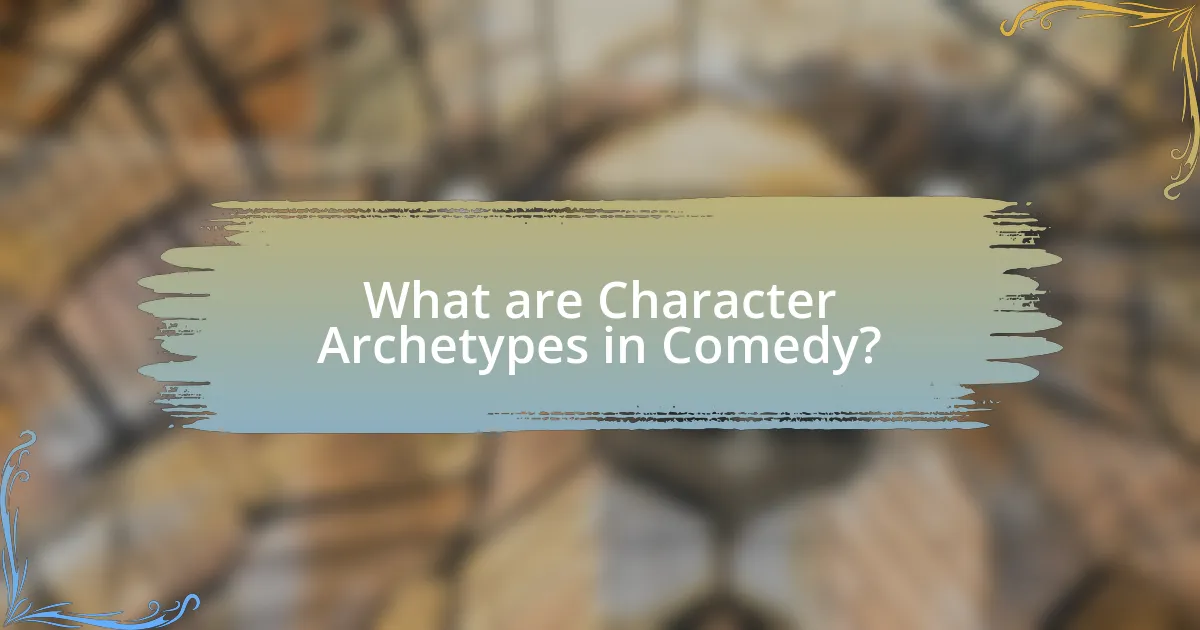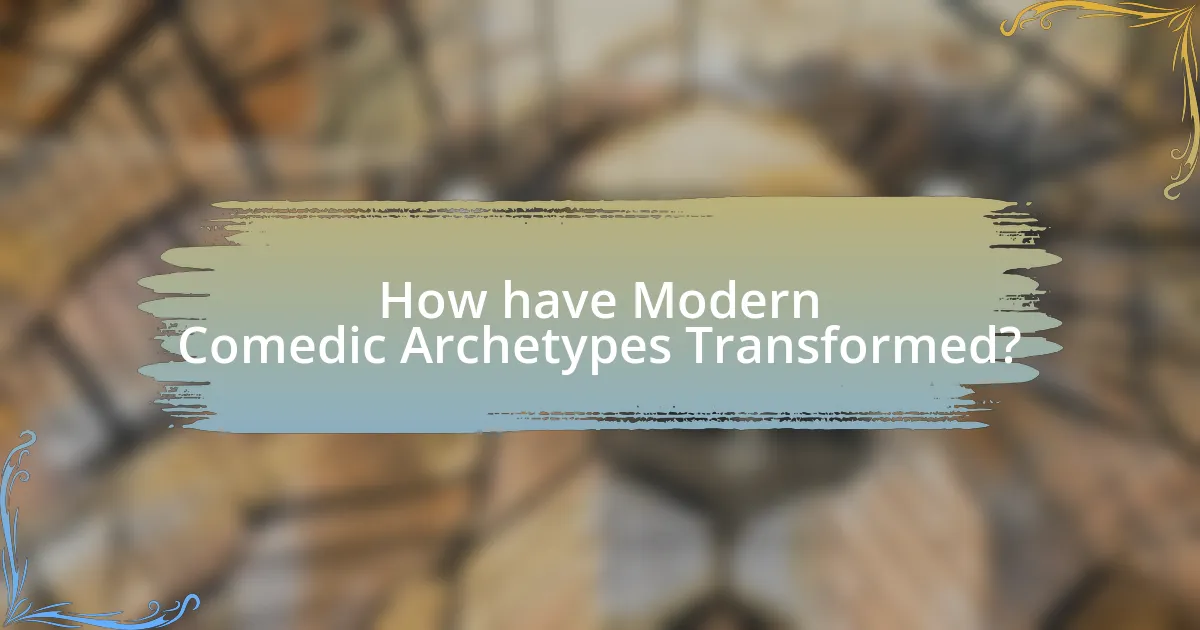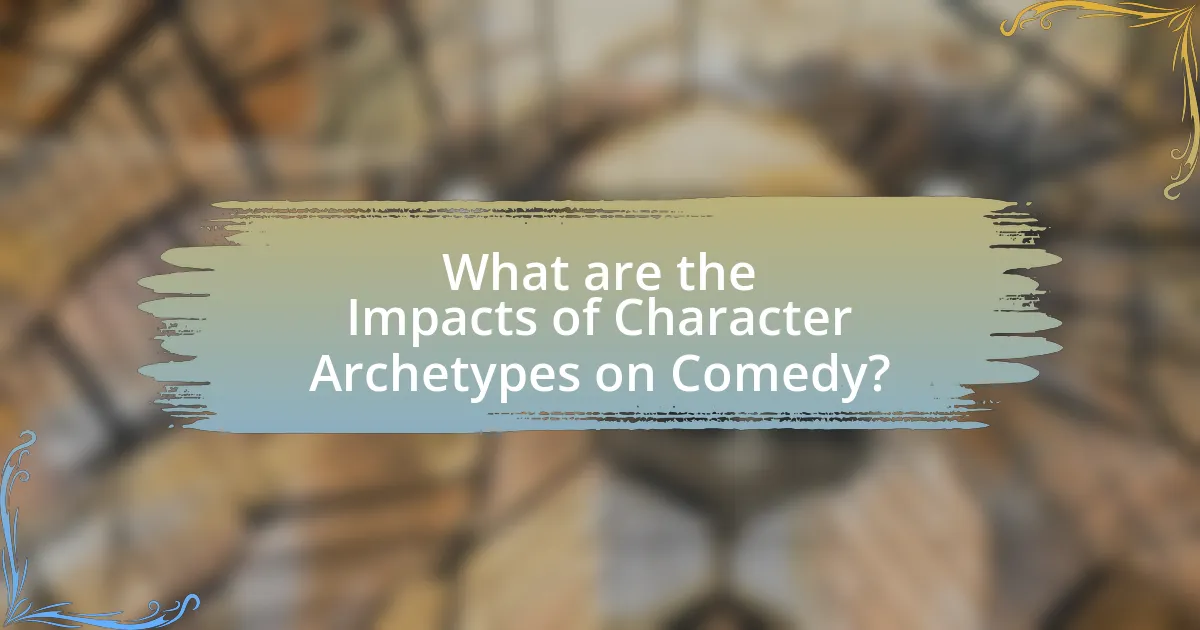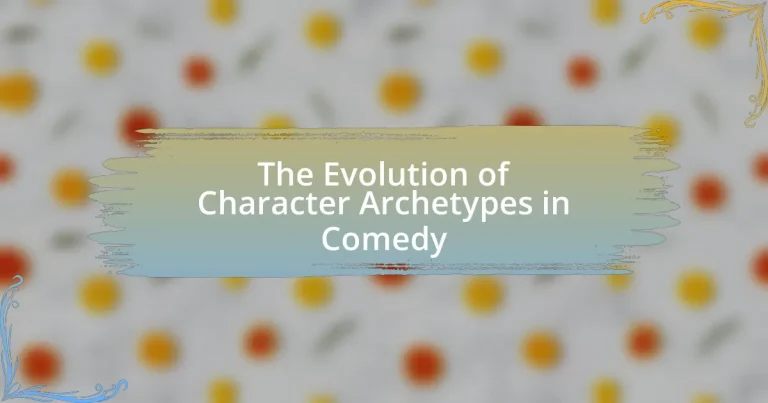The article examines the evolution of character archetypes in comedy, highlighting their significance in shaping humorous narratives. It explores traditional archetypes such as the fool, straight man, and romantic lead, detailing their roles and interactions that generate humor. The discussion extends to the historical influences that shaped these archetypes, societal changes that prompted their evolution, and the emergence of modern archetypes reflecting contemporary values. Additionally, the article addresses the importance of diversity in comedic representation and the challenges faced by diverse archetypes in mainstream comedy, ultimately emphasizing how these developments impact comedic storytelling and audience engagement.

What are Character Archetypes in Comedy?
Character archetypes in comedy are recurring character types that embody specific traits and roles, often used to elicit humor. These archetypes, such as the fool, the straight man, the wisecracker, and the romantic lead, serve as recognizable templates that guide comedic narratives and interactions. For example, the fool often provides comic relief through their naïveté, while the straight man highlights the absurdity of other characters’ actions. The consistent use of these archetypes across various comedic works, from classic literature to modern films, demonstrates their effectiveness in creating relatable and engaging humor.
How have character archetypes evolved in comedic narratives?
Character archetypes in comedic narratives have evolved from rigid, predictable roles to more nuanced and diverse representations. Historically, early comedic archetypes, such as the fool or the trickster, were often one-dimensional, serving primarily to elicit laughter through slapstick or simple misunderstandings. However, contemporary comedic narratives have introduced complex characters that reflect a broader range of human experiences and societal issues. For instance, characters like the “relatable everyman” or the “flawed hero” have emerged, allowing for humor that resonates on a deeper emotional level. This shift is evidenced by shows like “The Office” and “Parks and Recreation,” where characters possess distinct personalities and growth arcs, making them more relatable and engaging to audiences.
What historical influences shaped early comedic archetypes?
Early comedic archetypes were shaped significantly by ancient Greek theater, particularly through the works of playwrights like Aristophanes, who utilized satire and exaggerated characters to critique society. The Roman influence further developed these archetypes, with figures such as Plautus and Terence incorporating stock characters like the clever slave and the braggart soldier, which became foundational in comedic narratives. Additionally, the medieval period introduced the commedia dell’arte in Italy, characterized by its use of masked characters and improvisation, solidifying archetypes like the zany servant and the foolish old man. These historical influences collectively established a framework for comedic archetypes that persists in modern comedy.
How did societal changes impact the development of these archetypes?
Societal changes significantly influenced the development of character archetypes in comedy by reflecting evolving cultural norms and values. For instance, the rise of feminism in the 20th century led to the emergence of strong female archetypes, such as the independent woman, which challenged traditional gender roles. This shift is evidenced by the popularity of television shows like “The Mary Tyler Moore Show” in the 1970s, which portrayed women in professional roles, thereby reshaping audience perceptions of femininity. Additionally, the civil rights movement prompted the inclusion of diverse racial and ethnic characters, as seen in shows like “The Cosby Show,” which presented African American families in a positive light, countering stereotypes. These examples illustrate how societal transformations directly shaped the archetypes in comedic narratives, making them more representative of contemporary issues and audiences.
What are the key characteristics of traditional comedic archetypes?
Traditional comedic archetypes are characterized by distinct personality traits and roles that elicit humor through their interactions and situations. Common archetypes include the fool, who embodies ignorance and naivety, often leading to comedic misunderstandings; the straight man, who provides a serious counterpoint to the antics of others, enhancing the humor through contrast; and the trickster, who uses cunning and deception to create chaos and laughter. These archetypes have historical roots in classical theater, such as commedia dell’arte, where specific roles like Harlequin and Pierrot were defined by their exaggerated traits and behaviors, establishing a framework for comedic storytelling that persists in modern comedy.
What roles do the fool, the straight man, and the romantic lead play?
The fool, the straight man, and the romantic lead serve distinct roles in comedy. The fool embodies humor through absurdity and folly, often providing comic relief and engaging the audience with their antics. The straight man acts as a foil to the fool, maintaining a serious demeanor that highlights the fool’s ridiculousness, thus enhancing the comedic effect. The romantic lead typically introduces a subplot of love, creating tension and emotional stakes that complement the humor, often leading to comedic misunderstandings or resolutions. These roles have evolved over time, reflecting societal norms and comedic styles, as seen in classic literature and modern films where each archetype plays a crucial part in driving the narrative and eliciting laughter.
How do these archetypes interact to create humor?
Character archetypes interact to create humor through their contrasting traits and dynamics, which generate comedic situations. For instance, the clash between a straight man and a fool often leads to humorous exchanges, as the fool’s absurdity highlights the straight man’s rationality, creating a comedic tension. This interaction is evident in classic duos like Abbott and Costello, where their differing personalities drive the humor. Additionally, archetypes such as the trickster and the authority figure create humor by subverting expectations, as the trickster’s antics challenge the authority figure’s control, leading to unexpected and funny outcomes. This interplay of archetypes is foundational in comedy, as it relies on the audience’s recognition of these familiar roles and their inherent contradictions, which elicit laughter.

How have Modern Comedic Archetypes Transformed?
Modern comedic archetypes have transformed by becoming more diverse and nuanced, reflecting societal changes and evolving cultural norms. Historically, archetypes like the “fool” or “straight man” dominated, but contemporary comedy now features complex characters that challenge stereotypes, such as the “woke” character who addresses social issues or the “anti-hero” who embodies flawed traits. This shift is evidenced by shows like “The Good Place,” which explores moral dilemmas through humor, and “Brooklyn Nine-Nine,” which incorporates diverse representation and social commentary. These transformations indicate a broader acceptance of varied narratives and a move away from one-dimensional portrayals in comedy.
What new archetypes have emerged in contemporary comedy?
New archetypes that have emerged in contemporary comedy include the “woke warrior,” the “relatable millennial,” and the “quirky outsider.” The woke warrior often embodies social justice themes, addressing issues like race, gender, and inequality through humor, reflecting a shift towards more politically conscious comedy. The relatable millennial archetype resonates with younger audiences by portraying everyday struggles, such as student debt and job insecurity, often using self-deprecating humor. The quirky outsider character highlights individuality and eccentricity, often challenging societal norms and expectations, which has become increasingly popular in shows like “The Good Place” and “Brooklyn Nine-Nine.” These archetypes illustrate the evolving landscape of comedy, where diverse perspectives and social commentary play a significant role.
How do these new archetypes reflect current societal norms?
New archetypes in comedy reflect current societal norms by embodying contemporary values, challenges, and identities. For instance, the rise of diverse characters, such as those representing various ethnicities, genders, and sexual orientations, illustrates a societal shift towards inclusivity and representation. This evolution aligns with movements advocating for equality, such as Black Lives Matter and LGBTQ+ rights, which have gained significant traction in recent years. Additionally, the portrayal of mental health issues in comedic narratives highlights a growing societal acceptance of discussing mental well-being, as seen in shows like “BoJack Horseman.” These examples demonstrate how new archetypes not only mirror but also influence the ongoing dialogue about social issues, reflecting the complexities of modern life.
What are examples of successful modern comedic archetypes?
Successful modern comedic archetypes include the “Awkward Everyman,” the “Sarcastic Best Friend,” and the “Overly Confident Antagonist.” The Awkward Everyman, exemplified by characters like Jim Halpert from “The Office,” resonates with audiences through relatable social blunders. The Sarcastic Best Friend, seen in characters like Chandler Bing from “Friends,” provides humor through witty remarks and commentary on the main character’s life. The Overly Confident Antagonist, represented by characters like Michael Scott in “The Office,” creates comedic tension through their misguided self-assurance. These archetypes have proven effective in engaging audiences and driving comedic narratives in contemporary television and film.
Why is diversity important in comedic character archetypes?
Diversity is important in comedic character archetypes because it enhances relatability and broadens audience appeal. When comedic characters represent a variety of backgrounds, experiences, and perspectives, they resonate with a wider audience, fostering inclusivity. Research indicates that diverse representation in media can lead to increased viewer engagement and satisfaction, as seen in shows like “Brooklyn Nine-Nine,” which features a multicultural cast and addresses various social issues through humor. This approach not only enriches storytelling but also reflects the complexity of real-life interactions, making comedy more relevant and impactful.
How does representation affect audience engagement in comedy?
Representation significantly affects audience engagement in comedy by fostering relatability and inclusivity. When diverse characters and perspectives are portrayed, audiences are more likely to connect with the material, as they see their own experiences reflected. Research indicates that shows with diverse casts, such as “Black Panther,” which grossed over $1.3 billion globally, demonstrate that representation can enhance viewer investment and emotional response. This connection leads to increased laughter and enjoyment, as audiences feel acknowledged and understood, ultimately driving higher engagement levels.
What challenges do diverse archetypes face in mainstream comedy?
Diverse archetypes in mainstream comedy face significant challenges, primarily due to stereotypes and limited representation. These archetypes often encounter typecasting, where they are confined to specific roles that reinforce cultural clichés, limiting their ability to portray a broader range of human experiences. For instance, studies show that characters from underrepresented backgrounds are frequently depicted in ways that perpetuate negative stereotypes, which can alienate audiences and hinder the acceptance of diverse narratives. Additionally, the lack of diverse voices in writing and production roles contributes to these challenges, as decision-makers may not fully understand or appreciate the nuances of different cultures, leading to a homogenized comedic landscape that fails to resonate with a wider audience.

What are the Impacts of Character Archetypes on Comedy?
Character archetypes significantly impact comedy by providing recognizable frameworks that enhance humor through relatability and exaggeration. These archetypes, such as the fool, the straight man, and the trickster, create a structure that audiences can easily understand, allowing for comedic situations to unfold naturally. For instance, the fool often embodies ignorance, leading to humorous misunderstandings, while the straight man serves as a foil, highlighting the absurdity of the fool’s actions. This dynamic is evident in classic comedies like “The Odd Couple,” where the contrasting personalities of Felix and Oscar generate comedic tension. Research indicates that archetypes facilitate audience engagement by tapping into shared cultural narratives, making the humor more accessible and impactful.
How do character archetypes influence comedic storytelling?
Character archetypes significantly influence comedic storytelling by providing recognizable frameworks that shape humor and character interactions. These archetypes, such as the fool, the straight man, and the trickster, create a foundation for comedic situations by establishing clear roles and expectations. For instance, the fool often embodies naivety and absurdity, leading to humor through misunderstandings and unexpected outcomes, while the straight man serves as a contrast, highlighting the absurdity of the fool’s actions. This dynamic is evident in classic comedies like “The Odd Couple,” where the contrasting personalities of Felix and Oscar generate humor through their interactions. The use of archetypes allows writers to craft relatable scenarios that resonate with audiences, enhancing the comedic effect by leveraging familiar character traits and behaviors.
What techniques do writers use to develop archetypes effectively?
Writers develop archetypes effectively through techniques such as consistent characterization, relatable motivations, and situational context. Consistent characterization ensures that archetypes maintain their defining traits throughout the narrative, allowing audiences to easily recognize and connect with them. Relatable motivations provide depth, making characters’ actions understandable and engaging; for example, a hero’s quest for justice resonates with universal themes of morality. Situational context places archetypes in scenarios that highlight their traits, such as a trickster in a chaotic environment, which amplifies their characteristics and enhances comedic effect. These techniques are supported by the principles of character development outlined in narrative theory, which emphasize the importance of coherence and relatability in storytelling.
How do archetypes contribute to the pacing and structure of comedy?
Archetypes contribute to the pacing and structure of comedy by providing recognizable character templates that facilitate quick audience engagement and comedic timing. These archetypes, such as the fool, the straight man, and the antagonist, create a framework that allows for predictable interactions and setups, which are essential for building tension and delivering punchlines effectively. For instance, the fool often sets up humorous situations through their naïveté, while the straight man provides a contrast that enhances the comedic effect. This dynamic structure allows for a rhythm in comedic narratives, where the audience can anticipate and react to humor, thus maintaining an engaging pace throughout the performance.
What lessons can be learned from the evolution of comedic archetypes?
The evolution of comedic archetypes teaches that humor adapts to cultural contexts and societal norms. As comedic archetypes have shifted from traditional figures like the fool or the trickster to more complex characters reflecting contemporary issues, they illustrate how comedy can serve as a mirror to society. For instance, the rise of the anti-hero in comedy, seen in shows like “The Office,” highlights a shift towards flawed, relatable characters that resonate with audiences facing real-life challenges. This evolution underscores the importance of relatability and social commentary in effective comedy, demonstrating that successful humor often reflects the zeitgeist and addresses the audience’s experiences and values.
How can aspiring comedians utilize archetypes in their work?
Aspiring comedians can utilize archetypes by incorporating recognizable character types into their routines to enhance relatability and humor. By leveraging archetypes such as the “everyman,” “trickster,” or “wise fool,” comedians can create characters that resonate with audiences, making their performances more engaging. Research indicates that archetypes tap into universal human experiences, allowing comedians to evoke laughter through shared understanding and familiarity. For instance, the “everyman” archetype often highlights relatable struggles, which can lead to comedic situations that audiences find amusing and authentic.
What best practices should be followed when creating new comedic characters?
To create new comedic characters effectively, focus on defining a clear and relatable motivation for the character. This motivation drives their actions and humor, making them more engaging to the audience. Additionally, ensure that the character has distinct personality traits that can lead to comedic situations, such as being overly confident or socially awkward.
Incorporating unique quirks or catchphrases can enhance memorability and comedic impact. Furthermore, consider the character’s relationships with others, as dynamics can create conflict and humor. Research shows that characters with strong, identifiable traits resonate better with audiences, as seen in successful shows like “The Office,” where characters like Michael Scott exemplify clear motivations and distinct personalities.





